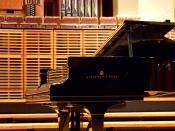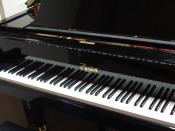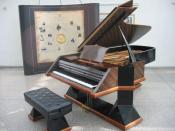The piano has seen many sights and has been a part of countless important events in the past and present. It is said to have dominated music for the past 200 years. Throughout history, inventions come along that take art away from princes and give it the people. Unlike the printing press, the piano made what was once intangible possible: the poorest of peasants could enjoy the same music that their beloved rulers did. The piano can be played by the rankest of amateurs, and the greatest of virtuosos so even if a person is not very intelligent, a simple tune can easily be learned. In addition to being a key factor in almost all western music styles, the piano has had a rich and eventful history.
The piano can be directly linked to two instruments of centuries past. The first is the clavichord, a box-like structure in which strings are stretched, and struck by metal blades to produce notes and pitches.
The clavichord could be manipulated to produce different chords, but even at it's best, could barely be heard by anyone other than the player. Intent upon creating a superior to the clavichord, musical engineers created the harpsichord. The harpsichord used a frame similar to modern grand pianos, but utilized a wooden bar and a quill to pluck strings (the jack), which amplified the sound of a clavichord greatly. Harpsichords were more expensive clavichords and became a fad in sixteenth and seventeenth century England. The harpsichord was a particularly important development leading to the invention of the piano.
However, the harpsichord was limited to one, unvarying volume. Its softness and loudness remained the same while playing. Therefore, performing artists could not achieve the degree of musical expression of most other instruments. The artistic desire for more controlled expression led...



Thanks.
Your eassy does help!
0 out of 0 people found this comment useful.